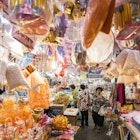
How to get around China: Here's how to navigate the Middle Kingdom with no problems

Oct 27, 2021 • 7 min read

Traveling around China is convenient and efficient with plenty of opportunities to get around slowly © Istvan Kadar Photography / Getty Images
Despite its vast distances and huge variety of landscapes, getting around in China is convenient and inexpensive. Sparkling bullet trains zip to all corners of the country, while buses connect smaller towns and villages. Air travel is also convenient and generally affordable from most major cities.
A combination of ridesharing and efficient metro systems will get you around Beijing, Shanghai and the larger metropolitan areas; you can also use a more traditionally Chinese mode of transport: two wheels. Here’s everything you need to know about getting around in China.

Train
Train travel is far and away the best way to get around China, for comfort, convenience and sustainability. China has the world’s longest and most-used high-speed railway network (nearly 2300km/1429mi). In between, slower express, local and overnight trains connect many smaller towns.
Upgrades and expansions to the railway network continue apace, with thousands of kilometers of new track laid each year, making it possible to get almost anywhere you want by rail. High-speed trains are usually brand new and ridiculously efficient, with both business and regular class sections comfortable and clean.
However, it’s on the slower, more traditional trains that you’ll see the best of China’s train culture, and have the chance to meet locals, exchange snacks and learn something new as you trundle through the Chinese countryside.
5 epic train journeys to take in China
Chinese train numbers are generally prefixed by a letter corresponding to the type of train. G, D, and C trains are luxurious high-speed trains, while Z, T, K are varying express and fast trains. Unnumbered services are the very slowest, with lots of stops.
Non-high-speed trains have an array of seat and sleeper options, ranging from hard seats (the cheapest and least comfortable) to soft sleepers (a four-bed compartment equivalent to first class). Train tickets are sold one way only and can be purchased from Trip.com up to 30 days in advance. Tickets are collected with a passport at the station on the day of travel.
Tip for holiday train travel: If you plan to travel during one of China’s national holidays, especially Spring Festival, buy your tickets as far in advance as possible, as most sell out rapidly and services are extremely busy.

Bus
For more remote parts of China and small villages, long-distance buses are often the only option. Bus travel tends to be much cheaper than train or air tickets, and it's relatively comfortable, with vehicles ranging from express coaches to smaller minibuses and overnight sleeper buses.
Intercity services are often sleek and clean with toilets and snack offerings, while in remote areas, particularly in the far west of the country, you can still experience a bygone age of rattling minibuses careening from village to village.
China is leading the way in electrifying its bus fleets (a whopping 99% of all the electric buses in the world are in China), with around 500,000 electric buses in operation around the country, most of them in cities.
Tip for buying tickets: Most bus tickets can be purchased at ticket windows on the day of travel, but are harder to get during national holidays.

Air
China’s airline industry has grown rapidly over the past decade, and there are now more than 240 airports – one in almost every provincial capital and major city. The relative newness of China’s air industry means that most airports are correspondingly sleek, modern and easy to navigate.
Airports are often located some distance outside of the city center, usually connected by either a metro system or dedicated express bus services from the terminal. A growing number of budget airlines have also begun operation after China deregulated its airfares in 2018.
The 10 most futuristic airports in the world
China’s major domestic airlines include China Southern, China Eastern, Air China, Hainan Airlines, Juneyao Airlines, Shanghai Airlines and Shenzhen Airlines. Tickets can be booked online at Trip.com (Ctrip inside China) or eLong.net.

Car
Only those with a Chinese driver’s license are allowed to rent a car in China, which makes road trips off-limits to most international visitors. In more remote parts of China, particularly the far west, it is possible to hire a private car with a driver (and sometimes a tour guide) to visit areas that are difficult to reach otherwise. This can usually be booked through a local hotel, hostel or travel agency.

Public transportation in cities
Most of China’s largest cities and provincial capitals have excellent public transportation networks that usually include subways, city buses and bike-share systems, as well as tram, light rail or maglev in some places. Metros in China are generally shiny, new, clean and air-conditioned.
In the largest cities, like Beijing, Shanghai and Hong Kong, local top-up cards can be used on most methods of transport, including buses. Tickets and transport cards can be purchased from machines in most subway stations, and bilingual signage in English and Chinese is ubiquitous.
China has put a huge amount of investment into greening its public transportation networks. For example, in 2018, the city of Shenzhen completed a holistic conversion to electric transport, with 16,000 e-buses and 22,000 electric taxis.

Didi and taxis
Uber is not present in China, but the local answer to ride-sharing is the Didi Chuxing app. Didi functions in English and has support for international credit cards, as well as the WeChat app wallet for payment. Didi cars tend to be more comfortable than local taxis, and the app eliminates language barrier angst, making it the best choice for visitors.
However, you can still hail a taxi on the street in a bind – non-Chinese speakers should make sure to have their destination written down in Chinese (such as the business card of your hotel).

Bicycle
Bicycles have always been a traditional method of transport in China (see: the 2001 film Beijing Bicycle) and are still an excellent way of getting around within a city. The bike-sharing economy veritably started in China, and you’ll find heaps – sometimes literally – of colorful rental bikes on street corners.
Though extremely cheap and convenient, these can sometimes present difficulty for international tourists, as the apps do not always support English-language or international-payment methods.
The 10 best long-distance bike rides around the world
Bike touring and long-distance cycling are also possible in China and are increasingly popular among locals. Given the distances in China, many cyclists opt for combined trips by bike and rail. Make sure you come well-equipped with flat-tire kits and backpacking equipment and don’t expect to wild camp without preparing in advance – you'll need the correct permits and permissions for tent camping. There are a few areas of China off-limits to international visitors, mainly in the far northwest, so long-distance cyclists must plan accordingly.

Boat
Travel by boat is increasingly rare in China, as the country has upgraded and added road and rail bridges in many areas. Some outlying islands – around Hong Kong, for example, or Putuoshan near Shanghai – are reachable by fast ferries. Tickets can generally be purchased at the terminal on the day of travel.
There are several scenic boat trips around the country, including rafting the Li River near Guilin and canal tours of Suzhou. Multi-day cruises down the Yangzi River, through the magnificent Three Gorges, remain popular and range from luxury ships with all the frills to simple, local boats for a much cheaper price. Travelers should understand the significant environmental and cultural impacts that the Three Gorges Dam project has had on the local area and communities, though, and take those into consideration before booking a cruise.
Accessible transportation in China
By and large, China remains a challenging place for accessible travel, with limited options for wheelchair users. The biggest cities have received significant upgrades, particularly Beijing, thanks to the attention surrounding the city’s hosting of the 2008 and 2022 Paralympic Games. Metro systems are generally new and usually have level-access platforms and elevators or stairlifts inside.
Access from street level can often be more difficult, however, as not every entrance has a lift. Accessibility options are often very limited on rural transport and anywhere outside of major cities.
For free downloads, including a phrasebook and a general guide to online resources, visit Lonely Planet's Accessible Travel portal.
You might also like:
5 epic train journeys to take in China
These top hikes in China are sure to take your breath away
Great Wall: get to know China's most iconic structure
Explore related stories








 Road TripsThe 8 best road trips in Malaysia for beaches, wildlife and more
Road TripsThe 8 best road trips in Malaysia for beaches, wildlife and moreJul 25, 2024 • 10 min read
 Destination PracticalitiesThe ultimate guide to visiting Tajikistan for the first time
Destination PracticalitiesThe ultimate guide to visiting Tajikistan for the first timeJul 18, 2024 • 6 min read
